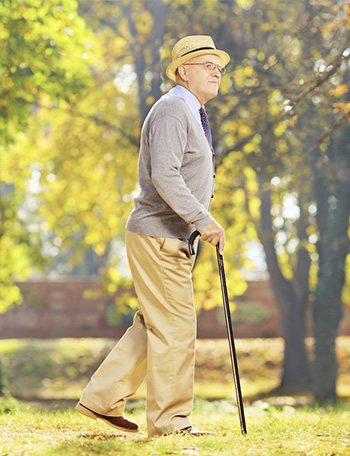More TV plus less physical activity increases risk of walking disability
Older people who watched more than five hours of TV per day and reported three or fewer hours per week of total physical activity had more than a three-fold higher risk of being unable to walk or having difficulty walking at the end of a study that ran for nearly a decade.
“The Joint Associations of Sedentary Time and Physical Activity with Mobility Disability in Older People: The NIH-AARP Diet and Health Study,” was published August 30 in The Journals of Gerontology, Series A: Biological Sciences and Medical Sciences. This research was supported in part by the National Cancer Institute at the National Institutes of Health.
The study assessed all types of sedentary behavior, as well as light, moderate, and vigorous physical activity, and observed that prolonged sitting and TV watching was particularly harmful -- especially when combined with low levels of total physical activity.
“TV viewing is a very potent risk factor for disability in older age,” said the study’s lead author, Loretta DiPietro, PhD, MPH, chair of the Department of Exercise and Nutrition Sciences at The George Washington University’s Milken Institute School of Public Health. “Sitting and watching TV for long periods-- especially in the evening-- has got to be one of the most dangerous things that older people can do because they are much more susceptible to the damages of physical inactivity.”
DiPietro and her colleagues analyzed data from the NIH-AARP Diet and Health Study, which kept track of men and women age 50 to 71 from six states and two metropolitan areas. All of the participants were healthy at the study’s start in 1995. The researchers recorded how much the participants watched TV, exercised or did gardening, housework or other physical activity at the beginning of the investigation, and then followed participants for about 10 years.
At the end of the study, nearly 30 percent of the previously healthy participants reported a mobility disability --having difficulty walking or being unable to walk at all.

The researchers observed that:
· Participants who watched five or more hours of TV per day had a 65 percent greater risk of reporting a mobility disability at the study’s end, compared with those who watched the least amounts of TV (less than two hours per day), and this association was independent of their level of total physical activity, as well as a variety of risk factors know to affect mobility disability risk.
· Increasing levels of total sitting and TV time in combination with low (three hours per week or less) physical activity were especially harmful, resulting in an acceleration of risk.
· Among those people in the most physically active group (greater than seven hours per week), total sitting of six hours per day or less was not associated with excess mobility disability.
· On the other hand, within all levels of physical activity, increasing amounts of TV viewing time increased the likelihood of a walking disability in a dose-response manner.
Other studies have found that too much sitting is a health hazard even for older people who meet the moderate-to-vigorous intensity physical activity guidelines of at least 150 minutes per week. But unlike this study, previous research did not follow people prospectively over a long period of time and did not consider the combined impact of both sedentary time and physical activity.
Younger people might be able to get away with sitting for long periods because they are physiologically more robust, DiPietro said. But after age 50, this study suggests that prolonged sitting and especially prolonged television viewing becomes particularly hazardous. TV viewing in the evening may be especially detrimental to health because it is not broken up with short bouts of activity, compared with sitting during the day, DiPietro added.
“We’ve engineered physical activity out of our modern life with commuting, elevators, the internet, mobile phones and a lifestyle -- think Netflix streaming -- that often includes 14 hours of sitting per day,” DiPietro said. “Our findings suggest that older people who want to remain fit must ramp up their daily physical activity and reduce the amount of time they spend sitting.”
To help reduce the risk, DiPietro suggested building more physical activity into daily life. For example, people who sit for long periods in front of a computer should get up every hour and/or switch to a standing desk. Commuters can park the car several blocks away from the office or decide to take the stairs. Older people should walk about as much as possible throughout the day, and everyone should consider binging less on television -- or at least marching in place during commercials or in between episodes.
“To stay active and healthy as you age, move more and sit less -- throughout the day -- every day,” DiPietro said.
Do you have news to share?
The ICAA welcomes your news submissions. Please send your press releases to colinmilner@icaa.cc-the ICAA's email for submissions-and staff will consider your news for possible publication. Newsworthy topics include such things as center/community openings; initiative or campaign launches; announcements of awards, promotions or grants; and other topics of interest to active-aging professionals.
Share



































